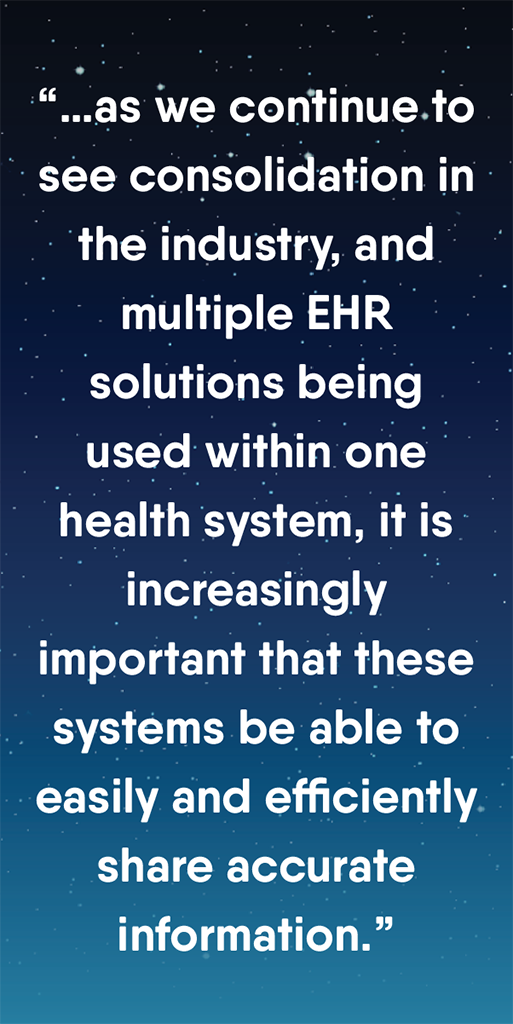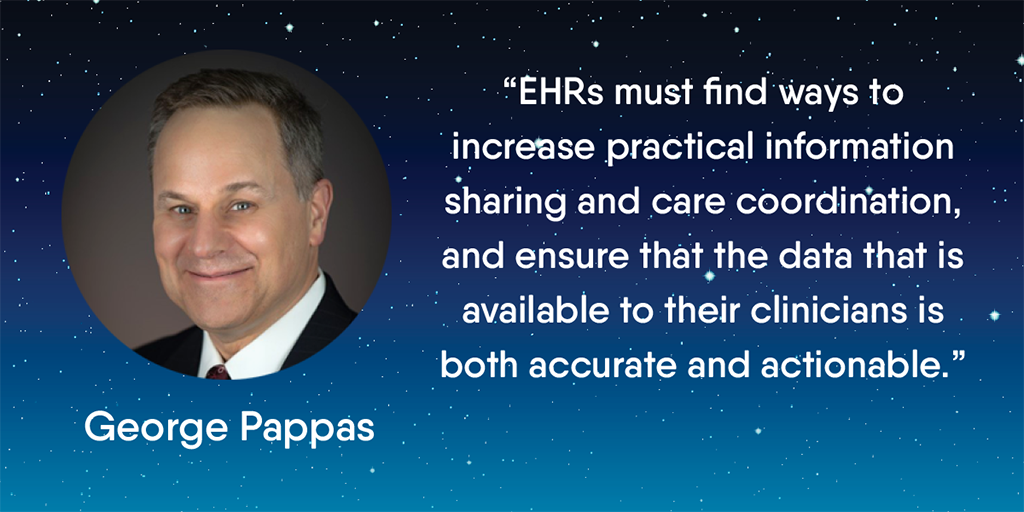George Pappas – Chief Customer Officer
The Healthiverse and EHRs – Enabling Interoperability in a Consolidating Healthcare Industry
This blog is part of a series introducing the concept of the Healthiverse, explaining why it’s essential to eliminate the siloes between care team members, and exploring the benefits that a more united healthcare universe can deliver to different key stakeholders in the industry.
Over the past two decades, we’ve witnessed growing consolidation in the healthcare industry which resulted from individual hospitals and practices being purchased and combined into larger health systems and integrated delivery networks (IDN). This trend has added to the already challenging problem of interoperability to raise the barrier to high quality care.
The combination of industry-wide adoption of EHR and EMR platforms with merged health systems, each with different EHR/EMR systems, has given rise to IDNs where a patient’s journey through the system could interact with three or more EHR’s, each with their own version of the truth for the same patient. The high switching costs involved in moving all hospitals and physician groups in a system to the same EHR platform has delayed or prevented the move to single EHR platforms systemwide.
While all of these realities slowed the progress to full interoperability across the healthcare industry and created considerable barriers to care coordination within healthcare organizations, there is hope. Vendor-agnostic tools are helping to pave the way toward true and efficient interoperability.
Accuracy and Organization Matter
Meaningful Use was the initial catalyst for hospitals to implement EHRs and rapidly digitize clinical information. EHRs have provided many benefits, yet they still have allowed many gaps in data and process to remain unaddressed. One of these is free text for clinical data that needed to be actionable within the system. Another is managing conflicting information from different sources that is needed by clinicians who are providing care.
This opened the door for patients to be inadvertently harmed because EHR clinical decision support rules were unable to detect and trigger alerts from free text, inaccurate patient med lists, and inaccurate physician orders. Some examples of this include medications that had been stopped a year ago were suddenly resumed, or medications that needed to be continued that were not identified and administered.
Since prescription sigs are often loaded into the an EHR and stored as unstructured data, medication history and reconciliation are an excellent example of how free text within EHRs can cause care collaboration and information sharing challenges between members of the care team.
Unstructured, free text data makes accurate medication reconciliation almost impossible. For medication reconciliation and information collaboration to be effective and verifiable, it needs to be organized in discrete fields.
The University of Michigan performed a study of 500,000 e-prescriptions1 to determine accuracy of the sigs and possibility of safe delivery. Eighty-four percent of these prescriptions needed editing – that’s more than 400,000 e-prescriptions. Due to issues of interoperability, pharmacists needed to manually transcribe and review these prescriptions – looking for missing pieces of information and errors – in order to print labels, instructions, and ensure that patients could take their medications safely.
At DrFirst, we began looking at the quality of the information as it entered these systems and found significant issues. A quality sig is one that is totally complete, as the provider intended. Before manual editing by the pharmacist, 51.4 percent of the e-prescriptions contained at least one quality issue. After being edited manually, 11.3 percent still contained at least one error. And, illustrating how likely an error can occur with manual intervention, one percent of the time an e-prescription that did not contain any errors originally, obtained an error in the manual entry process.
This evidence of incomplete and incorrect sigs being shared across the care team illustrates how unstructured and free text data are creating inefficiency and increasing risk. And while this is a problem for any hospital or provider, it’s a serious issue for the large healthcare organizations with multiple EHRs.
Consolidation Concerns
The mergers and acquisitions that we’ve witnessed over the past 20 years have exposed a larger challenge in the quality and quantity of healthcare and patient data, and worsened the interoperability problem that impedes collaboration and communication across the organization.

When multiple hospitals join together into a single health system, separate systems, processes, and data management strategies are merged together. One organization’s inaccurate data is married with another’s, and the potential for even more incorrect information entering the system increases.
Having inaccurate or incomplete data being utilized in the delivery of care within one organization can have serious negative impacts. Sharing that information with other members of the care team, and across all organizations within a large health system, effectively pours fuel on the fire.
Each different hospital or practice that is acquired or merged with a health system or IDN may not be using the same EHR system within their organization. If you look at any large IDN today, they will usually have at least two EHRs across their post-acute centers, ambulatory centers, and other offerings.
To remedy these issues, EHRs must find ways to increase practical information sharing and care coordination, and ensure that the data that is available to their clinicians is both accurate and actionable.
Next-Generation Solutions
New vendor-agnostic technologies have emerged that natively integrate with a variety of EHR solutions, bolstering their functionality, adding capabilities, and allowing a better form of interoperability.
These technologies are particularly attractive for EHR providers and health systems because they deliver increased and improved functionality and capability without the need for their engineers and developers to invest the time and effort to build them from scratch.
Applications, such as DrFirst’s Backline, enable members of a care team to collaborate and share information even if they’re utilizing different EHR solutions. Backline’s care collaboration platform provides HIPAA-compliant messaging, telehealth, document and image sharing, and forms completion effectively integrating teams in and outside of the patient’s current care setting.
Discrete and actionable information being accessed within the EHR can now be verified between teams, and with clients directly, in a secure manner. IDNs and health systems that may be using two or more EHR solutions across their organization can still enable their care team members to collaborate, communicate, and share patient data freely.
DrFirst solutions, such as MedHx, which uses our patented SmartSig Artificial Intelligence (AI) technology to clean data, de-duplicate and codify information, and ensure medication history is accurate. Our solutions also display information at the point of care, in a rolled-up fashion, grouping medication details and other patient data in ways that make it easier to find, digest, and take action on. This improves clinician workflows, enhances the quality of the data that they’re using, and ultimately delivers better patient experiences and outcomes.
DrFirst’s SmartSig solution also helps to solve the problem of unstructured, free text sig data2. The solution populates unstructured data into standardized form fields, infers missing data to ensure that it’s both complete and accurate, and converts drug data and information to your organization’s standardized terminology that makes sharing data easier and more effective.
All told, SmartSig has been used in millions of drug transactions across the United States and Canada. In one example, MedHx has managed to save 30 seconds per prescription and reduce the keystrokes and clicks needed to reconcile drug information by more than 80 percent. That means SmartSig has saved healthcare workers the equivalent of more than 2,000 days’ worth of time that would have otherwise been spent inputting or correcting sig data.
Recently, King’s Daughters Medical Center had an 11% decrease in readmissions from using MedHx and SmartSig3. These tools, when utilized alongside existing EHRs, save time, money, and a better continuum of care for patients.
While consolidation in the healthcare industry is a major trend, so is the movement towards value-based care. And as we continue to see consolidation in the industry, and multiple EHR solutions being used within one health system, it is increasingly important that these systems be able to easily and efficiently share accurate information. Making sense of the data, making it usable, complete, and error-free are all requirements to help clinicians ensure the best possible patient outcomes.
At DrFirst, it is our mission to connect everyone in the healthcare universe in real-time to each other and to the information they need, so patients get the best care—we call it uniting the Healthiverse. We’re excited to be making that possible through vendor-agnostic tools that complement EHR systems – increasing functionality and capability and making them work better for the clinicians, and patients, that rely on them.
1 BMJ Quality & Safety – https://qualitysafety.bmj.com/content/early/2020/05/24/bmjqs-2019-010405
2 SCRIPT Implementation Recommendations Version 1.54 – https://www.ncpdp.org/NCPDP/media/pdf/SCRIPT-Implementation-Recommendations.pdf
3 Rural hospital improves meds reconciliation via AI automation into EHR – https://www.healthcareitnews.com/news/rural-hospital-improves-meds-reconciliation-ai-automation-ehr



















